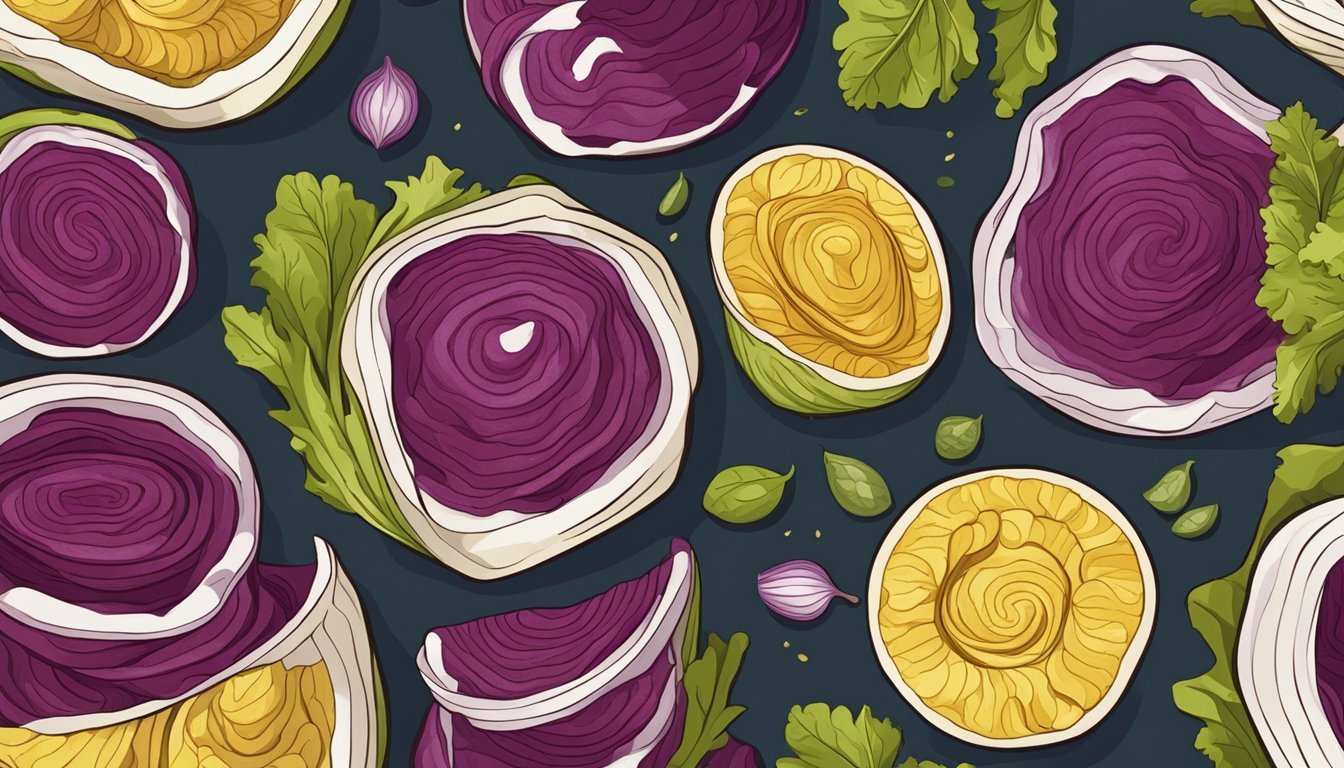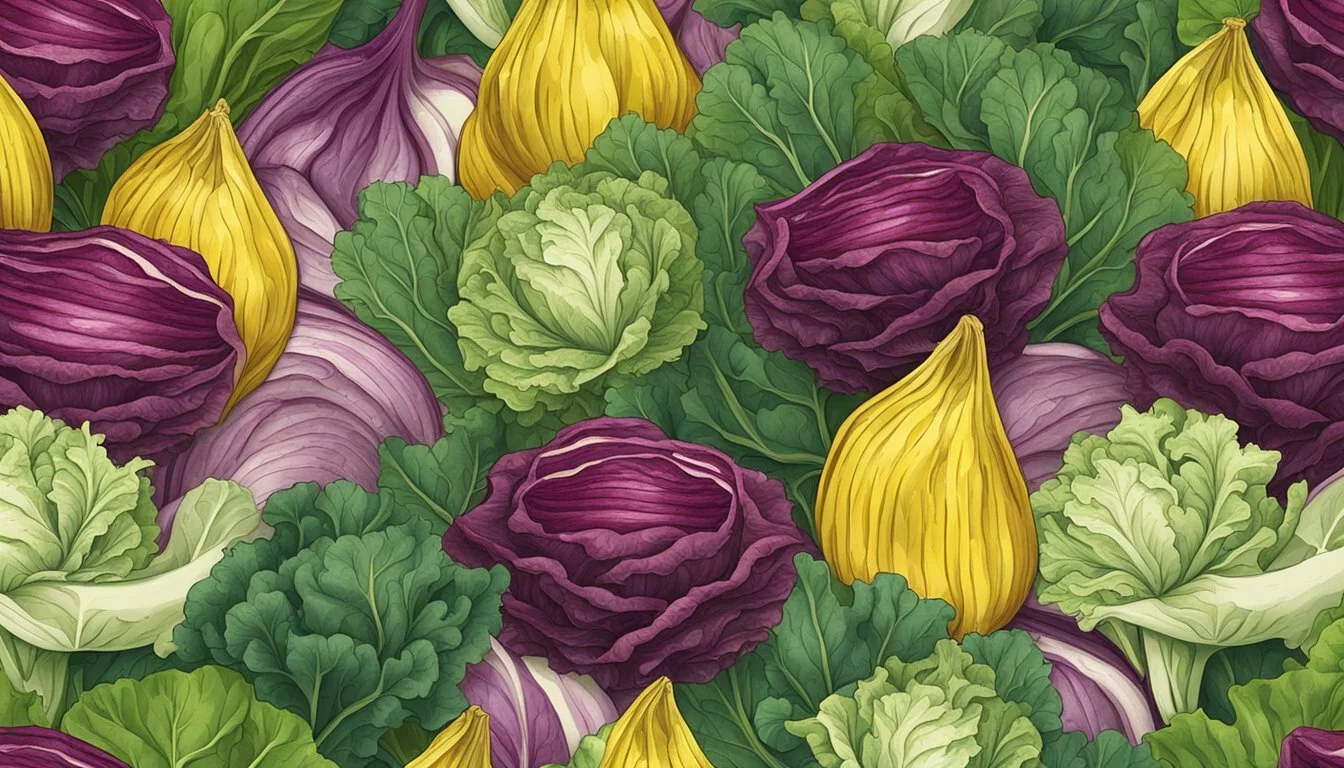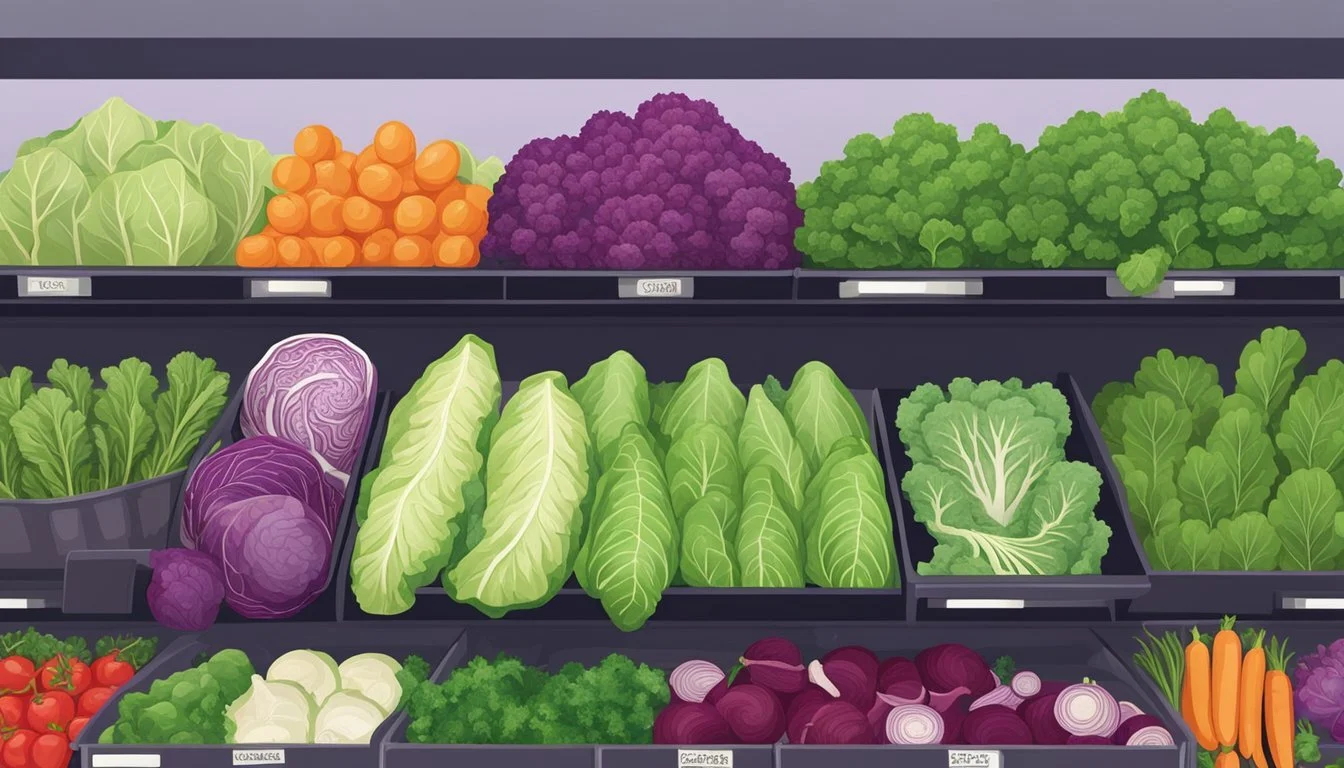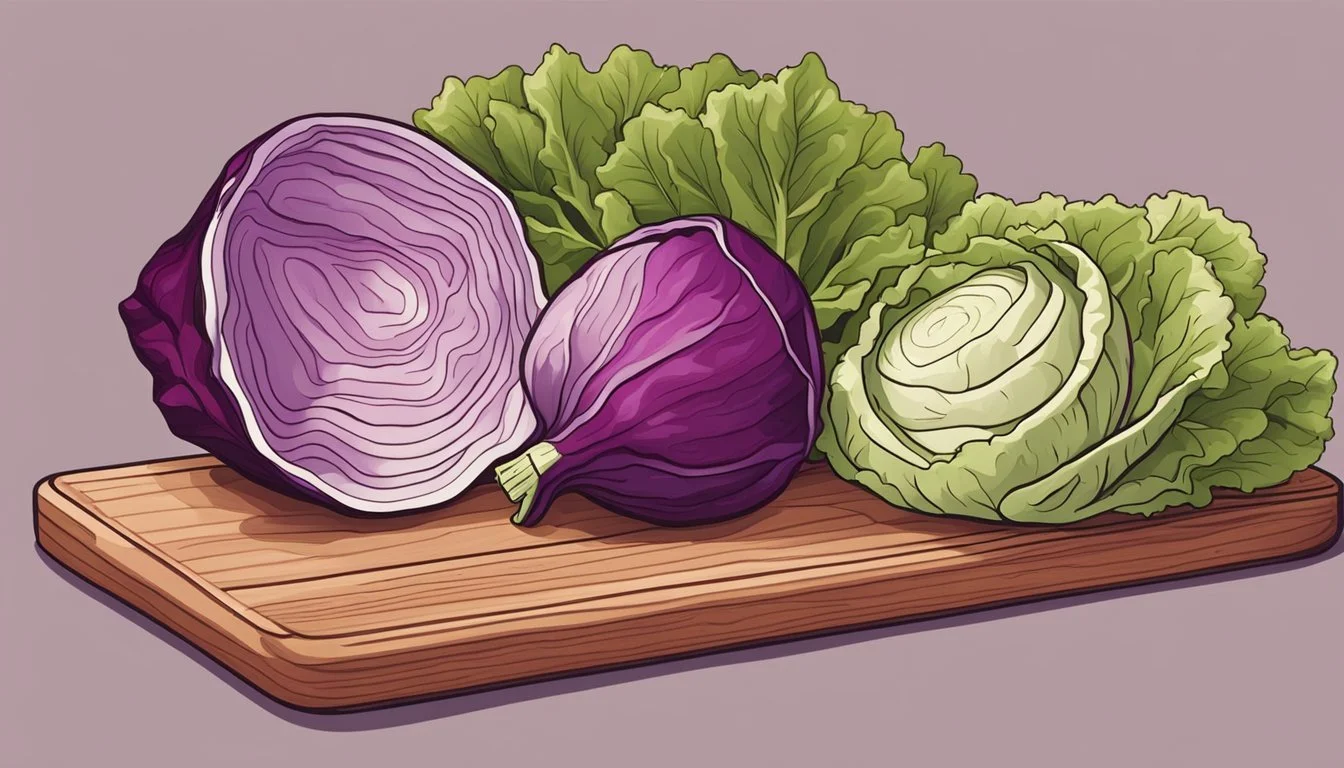Radicchio Substitutes
Top Alternatives for Your Salads and Dishes
Radicchio, also known as Italian chicory, is a distinctive leafy vegetable prized for its bold, peppery flavor and vibrant red-purple leaves that add a splash of color to dishes. Its flavor profile is characterized by a natural bitterness that can be mellowed through grilling or roasting, making it a versatile ingredient in salads, pastas, and as a garnish. This bitterness, a defining characteristic of radicchio, is due to the presence of intybin, a compound which stimulates the appetite and aids digestion.
However, the unique taste and appearance of radicchio might not be to everyone's liking or may not always be readily available in all markets. Fortunately, there are several substitutes that can mimic its color and texture while offering a similar bitter note or a milder taste, according to one's preference. These substitutes range from other leafy vegetables like endive and arugula to more robust options such as red cabbage, each providing their own distinct benefits and culinary uses.
The choice of substitute will largely depend on the specific requirements of the recipe and personal taste. For instance, endive offers a comparable bitterness with a slightly different texture, while arugula brings a peppery note with tender leaves. On the other hand, red cabbage can imitate the color of radicchio to some extent and provides a crunchy texture that stands up well in cooked dishes. When selecting an alternative, it is important to consider these factors to ensure the essence of the dish is maintained.
Understanding Radicchio
Radicchio, known for its bold flavor and vibrant hue, is an Italian leafy vegetable that imparts a unique bitter taste and a plethora of nutritional benefits to various dishes.
Origins and Characteristics
Radicchio, Cichorium intybus, is an Italian leafy vegetable with roots tracing back to the Veneto region. It is distinguished by its rich red color and contrasting white veins. The most common variety of radicchio is Chioggia, recognizable by its small, round, and cabbage-like shape. Treviso, another variety, is longer with an oblong shape and exhibits milder bitterness compared to Chioggia. Radicchio's hallmark is its pronounced bitter flavor, attributed to the presence of intybin, a compound that stimulates appetite and digestion.
Nutritional Profile
Radicchio is not only visually striking but also packs a nutritional punch. High in fiber, it supports digestive health while being low in calories, making it a favorable addition to weight management diets. Radicchio is a solid source of vitamin K, essential for bone health, and contains other vitamins and antioxidants that confer various health benefits.
Nutrient Benefit Fiber Aids in digestion and satiety Vitamin K Supports bone health Antioxidants Protects cells from oxidative stress
Radicchio adds a bold burst of color, a pleasing crunch, and a dash of bitterness that can elevate the flavor profile of salads and cooked dishes, making it a valued component in Italian and international cuisines.
Culinary Uses of Radicchio
Radicchio, with its vibrant crimson leaves marked by white veins, is a staple in Italian cuisine renowned for its fresh, bitter flavor. This leafy vegetable is capable of adding a pop of color and a unique taste to a variety of dishes, whether served raw or cooked.
Raw Preparation
In raw preparations, radicchio is often sliced thinly and added to salads to introduce a hint of bitterness that can complement the sweetness of other ingredients. Radicchio’s crisp texture makes it an excellent choice for salads, imparting both freshness and a visual appeal. A classic Italian salad might mix radicchio with endive and arugula, drizzle it with a dressing of olive oil and balsamic vinegar, and optionally top it with shavings of Parmesan cheese.
Salad Example:
Mix radicchio, endive, and arugula.
Dress with olive oil and balsamic vinegar.
Top with Parmesan cheese (optional).
In its raw form, radicchio can also serve as a crunchy vehicle for dips or be used as a garnish, providing a bold contrast to more neutrally flavored dishes.
Cooked Applications
When cooked, radicchio's bitterness mellows and a subtle sweetness emerges. It can be grilled to create a warm, charred side dish or chopped and mixed into pasta to add depth to the flavor profile of the dish. Additionally, radicchio can be sautéed with garlic and olive oil for a simple yet flavorful addition to risottos or included in soups for a slight bitter counterpoint.
Cooking Applications:
Grilled as a side dish.
Chopped into pasta dishes.
Sautéed with garlic and olive oil for risottos.
Incorporated into soups.
Whether incorporated raw into a crisp salad or cooked into a rich pasta, radicchio remains a versatile ingredient in the kitchen.
Choosing Radicchio Substitutes
When selecting a radicchio substitute, one must consider how closely the alternative matches radicchio's distinctive bitter taste and crunchy texture, ensuring it complements the flavors of the dish.
Factors to Consider
Flavor Profile: Radicchio is known for its bold, peppery, and slightly bitter flavor. When looking for substitutes, it's important to assess whether a milder or similarly bitter taste is desired.
Texture: Radicchio has a crunchy and firm texture. Substitutes should offer a comparable crunch to maintain the integrity of the dish.
Color and Presentation: Radicchio's vibrant red and white coloration can be a standout feature in dishes; consider the visual appeal of the substitute.
Best Substitute for Specific Dishes
Salads: A balanced alternative for salads is arugula, offering a peppery taste with a more tender crunch.
Substitute Flavor Texture Color Endive Mild Crunchy Pale Arugula Peppery Tender Green Chicory Bitter Firm Varied
Cooked Dishes: For recipes that call for cooked radicchio, red cabbage can withstand heat and maintain a satisfactory texture, though it has a sweeter flavor profile.
Understanding that the concept of a substitute is to maintain a balance of flavors and texture that original ingredients provide is essential. When radicchio is not available, these substitutes serve to fill its niche both in flavor and as a key ingredient in recipes.
Radicchio Substitutes List
When radicchio isn't available, or you seek an alternative with a less bitter taste or different texture, there are numerous options to consider. Leafy greens and cruciferous vegetables offer distinct qualities that can complement various dishes where radicchio is typically used.
Leafy Green Alternatives
Leafy greens can be a great alternative to radicchio, providing a similar texture with varying degrees of bitterness and peppery flavors. They are versatile ingredients that adapt well to salads, sautés, and other dishes where radicchio would be used.
Endive: A close relative of radicchio sharing a slightly bitter taste. It comes in two varieties: Belgian endive, known for its small, cylindrical head and pale color, and French endive or frisée, which has a frilly texture.
Arugula: A leafy green with a peppery taste, it offers a tenderness with a bit of crunch, which can suit salads well.
Escarole: A broader, less bitter leaf that is more affordable and available year-round. It works well in both raw and cooked applications.
Chicory: Known for its crisp texture and bitter flavor, chicory functions well as a radicchio substitute when raw in salads.
Romaine Lettuce: With its crunch and slightly bitter taste, it's often used as a more mellow substitute for radicchio.
Watercress: It brings a peppery flavor, similar to arugula, and serves as a nutritious substitute.
Dandelion Greens: These have a bitter edge that can mimic radicchio's flavor profile, especially when young and tender.
Mustard Greens: Known for their spiciness, they contribute a sharp, peppery kick to dishes.
Red Leaf Lettuce: Offers a red color akin to radicchio and a milder flavor suitable for those who find radicchio too intense.
Cruciferous Vegetable Options
Cruciferous vegetables, similar in texture to leafy greens but often with a more robust structure, can provide a hearty substitute with distinctive tastes and health benefits.
Red Cabbage: It has a crisp texture and vibrant red color that can visually substitute for radicchio in slaws and salads.
Kale: Available in varieties that can range from quite bitter to more neutral, kale offers robustness that holds up well in cooking.
Incorporating Substitutes in Recipes
When replacing radicchio in various dishes, one should consider texture, flavor, and preparation method to maintain the integrity of the original recipe.
Salads and Cold Dishes
In salads and cold dishes, radicchio's characteristic crunch and bitterness are pivotal. Endive and frisée serve as ideal substitutes as they provide a similar texture. When replacing radicchio with these options, chefs can maintain the balance between crunchy and leafy components in the dish.
Endive: Slightly less bitter but maintains crunchiness.
Arugula: Tends to be more peppery with a softer texture.
For those looking to mimic radicchio’s vibrant hue, red cabbage can be shredded thinly and mixed in salads. This alternative imparts a crunchy texture and a pop of color while being less bitter.
Warm Dishes and Sides
When radicchio is cooked, its bitterness mellows, and it's this particular characteristic that should be matched by its substitute. In warm dishes and sides, a chef might opt for:
Treviso: Similar to radicchio but with a gentler bitterness.
Red Cabbage: Holds up well when cooked and introduces a mild, sweet note.
Substitute Flavor Notes Suggested Usage Treviso Mildly bitter Braise alongside meats Red Cabbage Mildly sweet Stir-fries or roasted dishes
When a recipe calls for the spicy notes of radicchio, chicory can be lightly sautéed as an alternative, adding a similar spicy aroma to the dish. Chefs can adjust the amount of chicory used to align with the desired level of spiciness and bitterness.
Shopping and Availability
When seeking out radicchio or its substitutes, one must consider the availability and seasonality of these leafy greens. They are varied in taste and texture, suitable for diverse cuisines, and can be found in markets at different times of the year.
Seasonality
Radicchio, a winter crop, is most readily available in the fall and winter months. This vibrant red or maroon leafy green should be firm and crisp to the touch when fresh. Its seasonal nature dictates its presence in the market, which can influence shoppers to consider alternatives during its off-seasons.
Substitute Accessibility
Substitutes for radicchio range in accessibility throughout the year. The following table lists common radicchio substitutes along with their availability:
Substitute Availability Endive Year-round Romaine Lettuce Year-round, peak in spring Curly Endive Year-round Arugula Year-round Watercress Year-round Chicory Year-round Red Cabbage Year-round, peak in fall Radish Year-round, varies by type Treviso Similar to radicchio Frisee Year-round
These leafy greens also offer a range of flavors and textures that can complement various ingredients and cuisines, making them practical alternatives when radicchio is not in season or available at the market.
Health Considerations of Substitutes
When considering radicchio substitutes for health reasons, it's important to take into account potential allergies and dietary restrictions. Each alternative brings its own nutritional profile, which can affect individuals differently depending on their health requirements and sensitivities.
Allergy Information
Endive: Rarely causes allergic reactions; a good choice for those with sensitivities.
Arugula: Contains compounds similar to mustard; caution for those with mustard allergies.
Chicory: Related to ragweed; may trigger symptoms in individuals with ragweed allergies.
Red Cabbage: Generally safe, but check for individual sensitivities.
Nutrient content in these substitutes may vary, but they typically provide vitamins and minerals beneficial for overall health. They can be incorporated into diets to enhance nutritional intake while respecting allergen concerns.
Dietary Restrictions
Vegetables: Endive, Chicory, Red Cabbage, Frisee
Nutrients Benefits Vitamin K Supports bone health Vitamin C Antioxidant properties Folate Aids in DNA synthesis and repair
Low-Carb Diets: Endive and arugula are low in carbohydrates, suitable for ketogenic or low-carb diets.
Vegan/Vegetarian: All substitutes are plant-based, making them ideal for these diets.
Gluten-Free: Radicchio substitutes are naturally gluten-free, aligning with celiac dietary needs.
In summary, substitutes offer diverse nutrients that can cater to various health and dietary considerations. They foster inclusion for individuals with ingredient sensitivity and allow for alternative choices to maintain balanced nutrient content.
Final Thoughts
When exploring alternatives for radicchio, often referred to as Italian chicory, understanding the unique flavor profile and culinary uses of this vegetable is crucial. Radicchio is known for its vibrant color, distinct bitterness, and slight peppery aroma, which can be challenging to replicate. However, several substitutes can fulfill similar roles in dishes, albeit with nuances in flavor and texture.
Common Substitutes:
Endive: Shares a similar crunch and bitterness, suitable for salads and cooked recipes.
Arugula: Offers a peppery taste with a tender texture, ideal for a raw, peppery kick.
Red Cabbage: Provides a striking color with a milder taste; excellent for adding volume to salads.
Watercress: Introduces a light, spicy flavor, often used as a garnish.
Varieties of radicchio, such as Treviso, have a milder flavor and can be an excellent option for those seeking to stay within the same family. It's important to adjust seasonings like salt when substituting to ensure the flavor is balanced and the bitterness is not overwhelming.
One's choice of substitute will vary depending on the desired outcome. For instance, while chicory offers a similar bitterness, frisée adds a whimsical texture to dishes. The selected substitute should complement the other ingredients and not overpower them.
In summary, chefs have a variety of options when radicchio is unavailable, and a good understanding of radicchio and its substitutes can ensure culinary success. Each substitute brings its unique qualities to the table, and savvy cooks will select based on the specific needs of their recipes.







